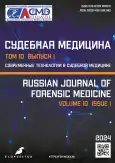恋童者体内植入芯片,作为化学阉割的替代措施
- 作者: Mukanov M.R.1, Begaliyev Y.N.2
-
隶属关系:
- The Kostanai Academy of the Ministry of Internal Affairs of the Republic of Kazakhstan named after Shyrakbek Kabylbayev
- Academy of Law Enforcement Agencies Under the General Prosecutors Office of the Republic of Kazakhstan
- 期: 卷 10, 编号 1 (2024)
- 页面: 5-14
- 栏目: 原创研究
- URL: https://journals.rcsi.science/2411-8729/article/view/254422
- DOI: https://doi.org/10.17816/fm15175
- ID: 254422
如何引用文章
详细
论证。本研究介绍对未成年人实施性犯罪的人体内植入芯片的可能性。芯片植入被视为化学阉割的替代措施。对妨害未成年人性权利不可侵犯罪的惩罚问题不如预防这种罪行的问题重要。令人失望的统计数字证实了这一事实。
该研究的目的是确定对恋童者的芯片植入技术与化学阉割相比有什么优缺点。
材料与方法。作者对哈萨克斯坦共和国关于对恋童者进行化学阉割和芯片植入的现行法律进行了分析,采用SWOT分析法确定了对恋童者芯片植入技术的利弊。
结果。目前,对某些类别公民的芯片植入尚未合法化。不过,已经有立法规定对嫌疑人和已决犯使用电子追踪装置。生物芯片很可能被视为这种装置。同时,将芯片植入作为另一种医疗性强制措施及列入刑事法律是合理的,这一点已经得到证实。
结论。从经济角度看,芯片植入比化学阉割便宜,从医学角度看,芯片植入更安全。唯一仍不如化学阉割的是立法控制和数据安全问题。这些问题的解决只是时间问题。
作者得出的结论是,对恋童者使用芯片植入技术是一种比化学阉割更有效、更便宜的替代措施。通过SWOT分析,可以确定对恋童者使用芯片植入技术的优势和劣势,以及该技术的能力和使用该技术的潜在威胁。结果显示了,该技术的优势大于劣势。
作者简介
Malik R. Mukanov
The Kostanai Academy of the Ministry of Internal Affairs of the Republic of Kazakhstan named after Shyrakbek Kabylbayev
编辑信件的主要联系方式.
Email: alik8385@mail.ru
ORCID iD: 0000-0002-4615-7666
SPIN 代码: 2316-5222
Scopus 作者 ID: 57210157241
Dr. Sci. (Philosophical)
哈萨克斯坦, KostanaiYernar N. Begaliyev
Academy of Law Enforcement Agencies Under the General Prosecutors Office of the Republic of Kazakhstan
Email: ernar-begaliev@mail.ru
ORCID iD: 0000-0001-6659-8576
SPIN 代码: 1929-3392
Dr. Sci. (Legal), Professor
哈萨克斯坦, Koshy参考
- Voevodkin DV, Rustemova GR, Begaliev EN, et al. Identifying fake conclusions of forensic medical examinations using an artificial intelligence technology based on the experience in the Republic of Kazakhstan: A review. Russ J Forensiс Med. 2023;9(3):275-286. EDN: EFNJIE doi: 10.17816/fm8270
- Orakbaev AB, Kurmangali ZhK, Begaliev EN, et al. On the issue of using the results of a virtual autopsy in criminal investigation: A review. Russ J Forensiс Med. 2023;9(2):183-192. EDN: OEERGD doi: 10.17816/fm774
- Tursunov AB, Galickij FA, Begaliev EN, et al. Forensic and forensic aspects of childhood traumatism as a result of domestic injuries and traffic accidents: A review. Russ J Forensiс Med. 2023;9(3):299-308. EDN: ORUBFH doi: 10.17816/fm12389
- Prihod'ko IS. Improving the activities of internal affairs bodies of the Republic of Kazakhstan on the prevention of sexual offences committed against children. In: Science of Young 2022: Collection of articles of the III International Research Competition. Part 2. Petrozavodsk; 2022. Р. 137-147. EDN: WUHBOI
- Alikperov HD. Global remote crime control: acceptability, opportunities, costs. Criminology: yesterday, today, tomorrow. 2016;(3):26-33. (In Russ). EDN: WWRTDB
- Wang Y. A review of microchip implant in human. In book: Proceedings of the 2022 6th International Seminar on Education, Management and Social Sciences (ISEMSS 2022). 2022. P. 92-97. doi: 10.2991/978-2-494069-31-2_12
补充文件









